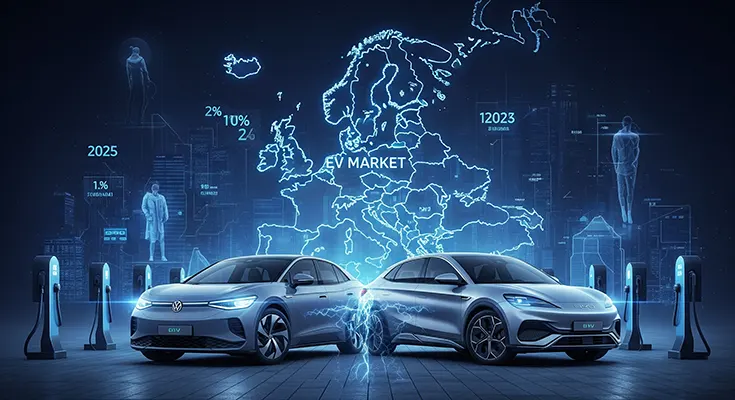The European electric vehicle (EV) market in 2025 is a dynamic arena, marked by intense competition and a significant shift in brand leadership. Driven by tightening emissions regulations and a growing consumer appetite for sustainable mobility, the market has seen both established European giants and ambitious new players from Asia vying for dominance. As the first half of the year concludes, key trends are emerging that define the competitive landscape.
A New Leader: Volkswagen Group’s Electrified Ascent
In a notable turn of events, the Volkswagen Group has cemented its position as Europe’s leading manufacturer of battery electric vehicles (BEVs). The German automotive giant’s comprehensive strategy of launching a diverse range of electric models across its brands, including Volkswagen, Audi, and Skoda, is paying dividends. The Volkswagen ID.4 and ID.7, along with the popular Skoda Enyaq, have all consistently ranked among the best-selling electric cars in the region, showcasing the group’s broad appeal and effective product strategy. This performance has allowed Volkswagen to consolidate a significant market share, outpacing rivals and solidifying its leadership in the transition to electric mobility.
Tesla’s Shifting Fortunes and Fierce Competition
For years, Tesla dominated the European EV market, with its Model Y and Model 3 frequently topping sales charts. While the Model Y remains a best-selling BEV in 2025, Tesla’s overall market share has faced increasing pressure. The brand has seen a decline in sales in the first half of the year, particularly in its traditional strongholds. This trend is attributed to several factors, including the launch of a new wave of highly competitive models from rival brands and some internal challenges related to production and brand image. The once-uncontested American leader is now facing a fierce battle to maintain its position, highlighting the maturing and increasingly competitive nature of the European EV market.
China’s Rising Stars: The BYD Challenge
Perhaps the most significant development in 2025 is the rapid rise of Chinese brands, led by BYD. In a landmark achievement, BYD has surpassed Tesla in monthly EV registrations in Europe, a testament to its aggressive expansion and compelling product lineup. BYD’s success is fueled by a strategy of offering a range of models at competitive price points, from the affordable Dolphin to the popular Seal U PHEV. The brand’s investment in European production, such as its new plant in Hungary, is also helping it navigate potential tariff hurdles and better serve the European market. Other Chinese brands like Leapmotor and Omoda are also making notable inroads, signalling a new era of competition for established European and American automakers.
Other Key Players and Market Dynamics
Beyond the top contenders, several other brands are making significant strides in the European EV market:
- BMW Group: The BMW Group, including the Mini and Rolls-Royce brands, has demonstrated strong growth in its electrified sales. With a growing portfolio of BEVs and a focus on premium and luxury segments, BMW is proving that its long-standing brand loyalty and engineering prowess are translating well into the electric age.
- Stellantis: As one of Europe’s largest automakers, Stellantis (with brands like Peugeot, Fiat, and Opel) has a crucial role to play. While its overall electrification journey is ongoing, the company’s performance has been mixed, with some brands showing growth while others have experienced a decline in EV sales. The group’s success hinges on its ability to roll out more affordable and popular electric models.
- Kia and Hyundai: The South Korean automotive groups continue to be strong contenders. Kia, in particular, has seen a positive performance with its new EV3 model entering the top ranks of best-sellers, showcasing the brand’s ability to combine technology with competitive pricing.
Overall, the European EV market in 2025 is defined by a clear trend: the era of single-brand dominance is over. With increased competition from a diverse range of players and a market that is quickly maturing, the race for market share is more intense than ever. As the continent moves closer to its ambitious 2035 zero-emissions target, the brands that can offer a combination of affordability, technological innovation, and a strong charging ecosystem will be the ones that ultimately win the hearts and minds of European consumers.













